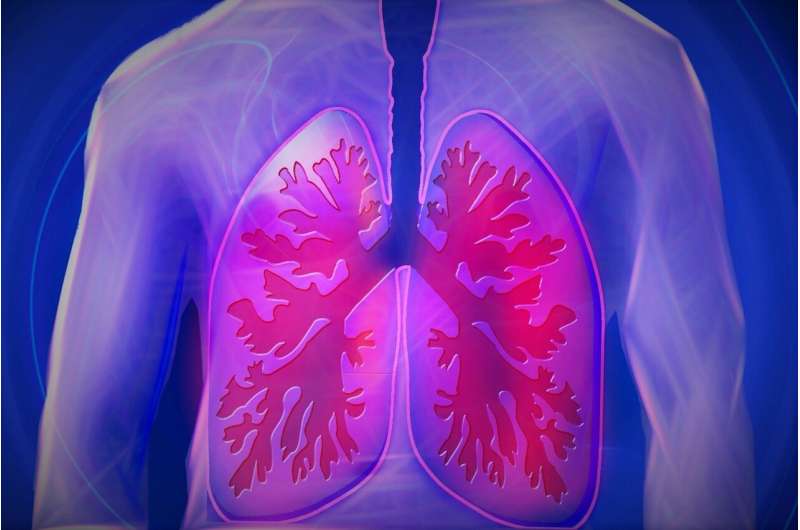This article has been reviewed according to Science X's editorial process and policies. Editors have highlighted the following attributes while ensuring the content's credibility:
fact-checked
trusted source
proofread
Breathing muscles remain strong after weeks of no training: Gains could improve endurance in those with lung conditions

Training the breathing muscles (primarily the diaphragm, which plays a vital role in breathing) could have longer lasting benefits than previously thought. The strength gains to the muscles from five weeks of inspiratory muscle training (a form of weight training to strengthen the muscles used to breathe) persist for five weeks after the training has stopped, according to new research published in Experimental Physiology.
Stronger breathing muscles may improve the distribution of blood flow during exercise, which allows a person to undergo physical activity for longer periods before tiring and becoming somewhat breathless. Enhancing breathing muscle function can potentially help people manage and slow down the progression of chronic obstructive pulmonary disease (COPD), a group of lung conditions including emphysema and bronchitis.
COPD is the third leading cause of death worldwide, but is helped with pulmonary rehabilitation, which can include inspiratory muscle training. Healthcare needs and the frequency of hospital visits depend on a person's symptoms and how regularly they worsen. For people with weak breathing muscles, the training may help relieve the symptoms.
Muscles can lose function or weaken over time with disuse, particularly the respiratory muscles, which may weaken faster than the other muscles in the body. The researchers from University of Waterloo, Canada found that the breathing muscles remain stronger after an equal amount of time without training—in this case, five weeks. Observations of similar muscle gains between weight training of the breathing muscles with that of the tibialis anterior (the muscle that runs down the front of the shin) indicate that the respiratory muscles can be trained like other skeletal muscles.
Paolo Dominelli, a study researcher from University of Waterloo, Canada, said, "Inspiratory muscle training can be beneficial to people with breathing difficulties and can be part of pulmonary rehabilitation. Knowing the timeframe before muscle function loss occurs could help inform treatment programs, determining how frequently an individual would need to train, and the length of the program."
Inspiratory muscle training also caused a positive change to the respiratory muscle metaboreflex, a process where the body restricts the blood flow to the limbs when the breathing muscles tire. Typically during exercise when the limb muscles are working hard, the respiratory metaboreflex prioritizes blood flow to the breathing muscles to ensure breathing is maintained. As a result, heart rate and blood pressure rise.
However, inspiratory muscle training reduces the metaboreflex, which lowers the heart rate and blood pressure. Reducing the metaboreflex may improves a person's endurance during exercise, meaning they can work out for longer before reaching exhaustion. The researchers found that the effects on the metaboreflex were preserved after five weeks in the absence of training.
Dominelli said, "By showing that the strength of the breathing muscles persisted, along with the retained reductions in the respiratory metaboreflex after five weeks without training suggests that the training itself may not need to be continuous. We would need to carry out subsequent clinical trails to test the appropriate frequency and length of training required to evaluate how long the health benefits persist."
A group of 16 young healthy adults were randomly assigned into either the control group (seven male, one female) or the experimental group (six male, two female). Over 10 weeks their respiratory muscle strength and muscle strength of their lower leg (via the ability to flex the ankle upwards) were tested in a laboratory, and their blood pressure and heart rate were measured at pre-training (zero weeks), post-training (five weeks) and post-detraining (10 weeks) while their respiratory muscles were working hard to elicit the metaboreflex.
Over five weeks the experimental group performed inspiratory muscle training twice a day for five days a week. This was then followed by five weeks of undergoing normal physical activity but no inspiratory muscle training (post-detraining). The control group did not take part in inspiratory muscle training. All participants engaged in regularly physical activity (approximately three days per week) throughout the 10-week study period.
Dominelli cautions, "Firstly, our study was done in young healthy individuals who are not limited by their respiratory muscles. Follow-up studies needs to be completed in those with lung disease such as COPD. Secondly, the main limitation of the study was the duration of the detraining (no training) period. It was only for five weeks, the same amount of time as the training, where we did not see any decreases in breathing muscle strength. Further studies should extend the detraining phase to see if the reduction in the metaboreflex still persists with decreases in muscle strength."
More information: The effect of inspiratory muscle training and detraining on the respiratory metaboreflex, Experimental Physiology (2023). DOI: 10.1113/EP090779. physoc.onlinelibrary.wiley.com … doi/10.1113/EP090779




















